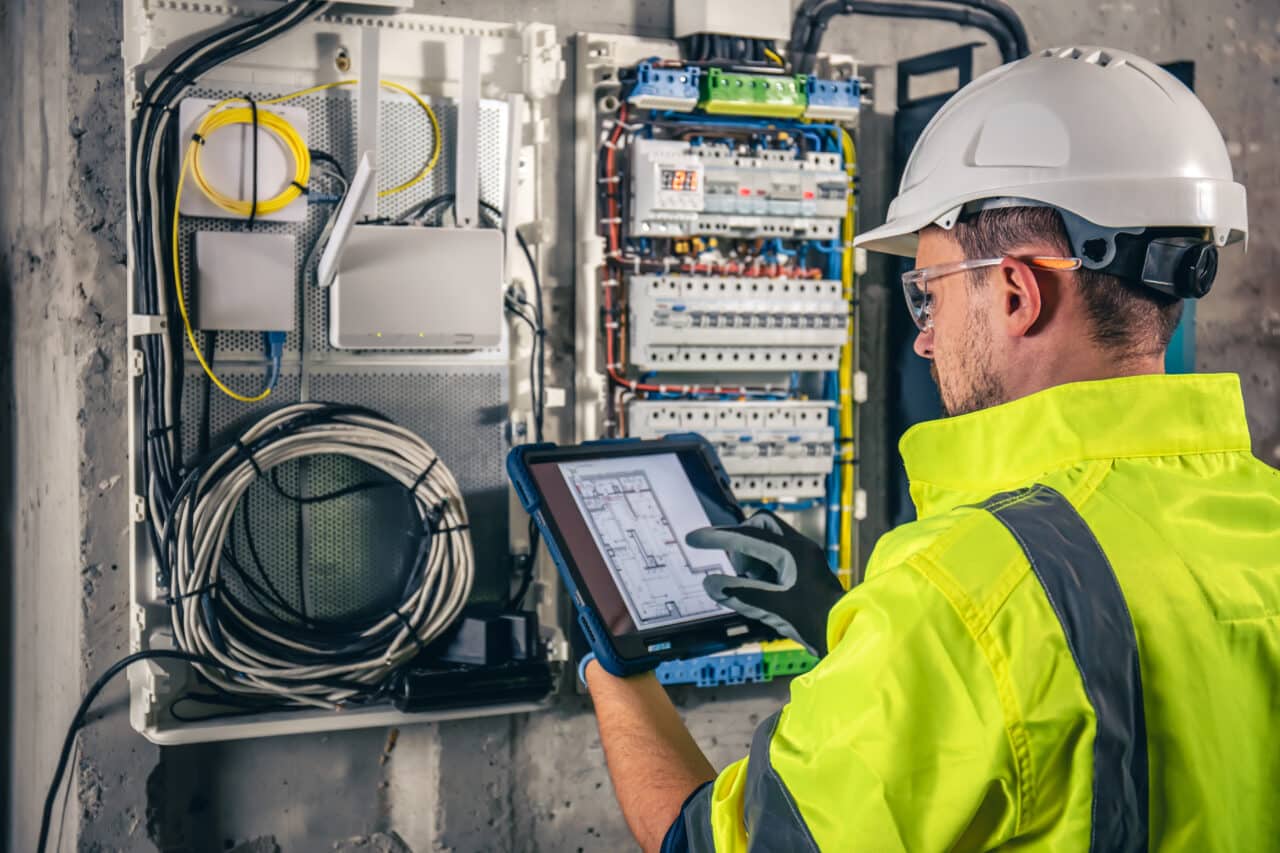When your electrical panel fails mid-shift, production stops, safety risks spike, and every minute drains revenue. For facility managers balancing compliance, energy demands, and aging infrastructure, the wrong panel is a major liability.
Can your system handle tomorrow’s load? Is it up to code? What happens if it fails again?
We’ve helped commercial facilities across the Southeast make smarter electrical decisions for 80+ years. In this guide, we’ll break down how to choose industrial circuit breaker panels based on six critical factors so that your next upgrade improves uptime, protects your team, and transforms your biggest electrical headache into your most reliable asset.
Key Factors in Selecting Industrial Panels
When choosing industrial circuit breaker panels for your facility, six key factors determine whether that panel will support safe, efficient, and future-ready operations—or create costly setbacks.
These factors are:
- Load capacity
- Voltage compatibility
- Safety and compliance
- Scalability
- Environmental durability
- Smart technology integration
Each plays a distinct role in maintaining uptime and preventing avoidable risks across your building’s electrical infrastructure.
Load Capacity
Your panel must support current peak loads and projected future demand. Undersizing leads to overload risks, unexpected shutdowns, and forced upgrades down the line. Oversizing drives up unnecessary costs.
Together, industrial and commercial buildings use more than 60% of the nation’s electricity, and that load isn’t spread evenly. Equipment startups, HVAC surges, and seasonal shifts all spike demand. If your panel isn’t sized for those fluctuations, it risks tripping, overheating, or forcing shutdowns when your facility can least afford it.
Voltage Compatibility
Choosing a panel with the wrong voltage rating can damage equipment or create compliance violations. Common commercial voltages include:
- 120/208V
- 277/480V
- 600V
The panel must match your building’s voltage system and transformer setup. This is especially important in multi-use facilities with mixed voltage needs.
Safety Standards & NEC Compliance
Panels should carry a UL listing and comply with the latest (National Electrical Code) (NEC) requirements.
The 2023 NEC update reorganized Article 100 to make safety terms easier to locate across different building types.
OSHA violations related to electrical safety can lead to downtime, fines, or worse, especially since 80% of reported electrical injuries in the workplace involve arc flash burns.
Scalability
Choose a panel with a modular design or space for expansion. Future renovations, added machinery, or building repurposing often require additional circuits. Scalability keeps your system adaptable and reduces the need for total replacement later.
Environmental Protection & Durability
Panels in industrial environments have to be resilient against dust, moisture, and corrosion risks. Select enclosures with appropriate NEMA or IP ratings based on the environment, especially in manufacturing, food processing, or outdoor areas.
NEMA ratings (like NEMA 3R, 4X, or 12) define protection levels against contaminants such as water, oil, and airborne particles, while IP (Ingress Protection) codes offer a similar standard used internationally.
Choosing the wrong rating could mean premature failure, safety hazards, or code violations.
Always match the enclosure to the actual conditions in your facility (not just what’s listed on paper).
Smart Technology Integration
Modern panels support energy monitoring, alerts, and predictive maintenance. This is increasingly important for data-heavy operations. Facilities with data centers, automation equipment, or energy-intensive systems need smarter oversight than a basic breaker panel can provide.
With data center power usage projected to hit up to 12% of U.S. electricity by 2028, smart panels give facility managers real-time visibility to prevent overloading, spot anomalies, and reduce waste … something manual inspections alone can’t deliver.
How to Evaluate Your Facility for Circuit Breaker Panel Upgrades
Below is a quick evaluation checklist to help you choose the right industrial circuit breaker panel for your facility. Use it during site walks, RFP reviews, or equipment upgrades to avoid costly oversights.
Total Load Assessment
Start by calculating your building’s current electrical load and projected growth over the next 5-10 years. Document both your peak demand and average consumption patterns. Don’t forget to account for seasonal spikes (like HVAC loads during summer), future expansions, or added systems like EV chargers, automation lines, or additional production equipment.
Consider building in a 20-25% capacity buffer to handle unexpected growth or temporary equipment additions.
Review the past 12 months of utility bills to identify load trends and peak demand charges that could impact your panel sizing decisions.
Infrastructure Compatibility
Double-check compatibility with your existing transformer capacity, service entrance configuration, and building wiring layout. Verify that your current grounding system, conduit runs, and cable pathways can accommodate the new panel installation.
An upgrade in one area may require adjustments elsewhere. Factor these cascading costs into your budget.
Consider the physical footprint and whether existing mounting structures can support the new panel’s weight and dimensions.
Safety & Compliance
The panel must carry a valid UL listing (UL 891 for switchboards, UL 67 for panelboards) and meet both current NEC and OSHA requirements for your specific industry.
Verify that the panel includes proper arc flash protection features and that all components meet the latest safety standards.
Check local AHJ (Authority Having Jurisdiction) requirements, as some municipalities have additional specifications beyond NEC minimums.
Make sure the panel design supports your facility’s lockout/tagout procedures.
Location & Accessibility
Evaluate whether the panel location meets NEC working space requirements (typically 3 feet clear in front, 30 inches wide).
Is the panel in a safe, dry, and easily accessible location for both routine maintenance and emergency shutdowns? Can your team lock it out quickly during emergencies without navigating through hazardous areas?
Look for adequate lighting, clear working space with no overhead obstructions, proper ventilation, and compliant safety signage.
Consider environmental factors like temperature extremes, humidity, dust, or corrosive atmospheres that might affect panel longevity.
Manufacturer Reputation
Evaluate the brand’s track record for reliability, warranty coverage (typically 1-2 years standard, with extended options), and local availability of replacement parts and service technicians.
A cheaper panel that’s difficult to repair, has long lead times for parts, or lacks local service support will cost significantly more over its 20-30 year lifespan.
Consider standardizing on one manufacturer across your facility to simplify maintenance, training, and spare parts inventory.
Step-by-Step Selection Process
This section outlines how to choose the best industrial circuit breaker panel for your facility so that you make an informed investment that balances safety, compliance, and long-term operational needs.
Step 1: Conduct a Full Load Analysis
Document your current electrical usage patterns, peak demand periods, and calculate projected growth over the next decade.
Include all equipment, lighting, HVAC systems, and any planned additions like automation or EV charging stations. This ensures your new panel will be sized for today’s needs and tomorrow’s expansion plans.
Step 2: Consult a Licensed Commercial Electrician and/or Engineer
Bring in licensed electricians or engineers early. A qualified professional can help you assess load data, interpret code requirements, and avoid costly oversights caused by incorrect panel specs or placement.
Our team can assess your specific requirements and recommend solutions tailored to your facility’s unique challenges and operational demands.
Step 3: Compare Specs and Capabilities
Evaluate panel features like breaker type, smart monitoring options, enclosure ratings, and modularity. Don’t default to the cheapest option. Ask yourself: Will this panel still meet our needs 5 years from now?
Step 4: Verify Code Compliance
The panel must meet NEC, OSHA, and local code requirements. With 150 fatal and 2,428 nonfatal electrical injuries reported annually, cutting corners here is a liability, not a savings.
Step 5: Evaluate Long-Term Value
Don’t just look at the initial price tag. Consider the total cost of ownership over the panel’s 20-30 year lifespan. Factor in ongoing maintenance costs, parts availability, energy efficiency, and the manufacturer’s service network in your region.
A reliable panel with strong warranty coverage and readily available components will save significantly more than you’ll spend on a budget option that fails prematurely or requires expensive emergency repairs. When facility electrical safety is on the line, the cheapest upfront choice often becomes the most expensive mistake.
Common Mistakes to Avoid When Choosing Industrial Circuit Breaker Panels
Facility managers often make a few critical mistakes when selecting or installing industrial circuit breaker panels … mistakes that can lead to costly downtime, failed inspections, or unsafe conditions. Avoid these at all costs:
Undersizing the panel
A panel that can’t handle current and future load demands will trip, overheat, or force shutdowns during peak operations. Always factor in 5-10 years of projected growth and seasonal demand spikes.
Prioritizing price over reliability
Cheaper panels often lack advanced safety features, reliable warranties, or smart capabilities. What looks like a cost-saving move can become a 6-figure failure when a panel goes down.
Overlooking certifications
Missing or outdated UL listings and failure to meet NEC compliance can lead to failed inspections, fines, or worse. Double-check that your panel meets OSHA and local AHJ requirements.
Poor placement
Installing a panel in damp, dusty, or exposed environments without the right NEMA or IP enclosure rating shortens its lifespan and increases safety risks, especially if maintenance access is limited.
Preventing these common electrical issues doesn’t stop at installation. Ongoing maintenance and planning are key to long-term panel performance, so be sure to:
- Schedule regular panel inspections (at least annually)
- Train maintenance staff on safe handling and lockout/tagout procedures
- Keep thorough documentation of all electrical maintenance and repairs
- Build upgrade plans into your facility’s long-term capital improvements strategy
Commercial Electrical Panel Installation Services That Prevent Downtime
When a critical panel failure shut down a Chattanooga facility, we restored partial power the same day, sourced a replacement panel in under a week, and completed a full installation with no long-term disruption. That facility avoided weeks of downtime. You can read the full case study here.
But this wasn’t a one-off. Our commercial electrical team responds to emergencies like this every month across the Southeast.
Whether you’re replacing outdated panels, upgrading to meet higher loads, or needing faster response when things go wrong, our qualified electricians have the expertise to get it done safely and efficiently. We offer:
- Commercial electrical panel installations and upgrades
- 24/7 licensed repair services for urgent electrical issues
- Facility Management and Maintenance Plans to prevent future failures
If your facility’s electrical system is outdated, underperforming, or putting uptime at risk, we’ll help you take control before it becomes a crisis. Request an appointment with a professional commercial electrician today!
Get expert help choosing your industrial panel today.
CALL US NOW AT 615.567.1000

